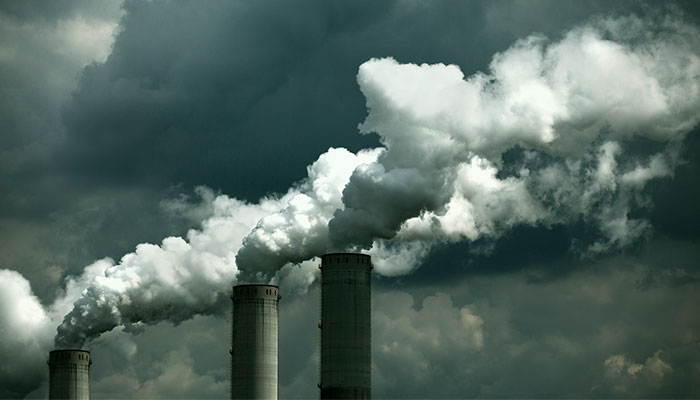A carbon price is a cost applied to carbon pollution with the goal of addressing climate change by reducing the greenhouse gas emissions generated in the production of electricity. The overwhelming majority of electricity is still produced by the burning of fossil fuels, such as coal. The idea is that pricing carbon encourages a reduction in emissions by making them more expensive.

The price of power: In Australia, the average emission intensity rate is roughly 0.8 tonnes of carbon dioxide per megawatt-hour electricity produced.
The Reserve Bank has put carbon pricing firmly back on the agenda. In March this year, Deputy Governor Guy Debelle said financial stability was "better served by an orderly transition to a low-carbon economy".
Essentially, pricing carbon comes down to a carbon tax versus an emission trading scheme.
Carbon Tax
A carbon tax will raise energy prices but does not necessarily ensure emissions will be reduced to the necessary level. It is difficult to set the right level of tax. If you set the tax too low, there may be little effect because companies would rather pay the tax than change their technology. If it’s set too high it could drive companies into financial stress, damage the economy and reduce GDP (Gross Domestic Product).
One could argue that if India, China and the US do not participate, there is no point in Australia doing anything but I believe a country that can afford to reduce emissions, like Australia, has a moral duty to act.
In Australia, the average emission intensity rate at the moment is roughly 0.8 tonnes of carbon dioxide per megawatt-hour electricity produced. So if you have a carbon tax with a price per tonne of CO2 emitted at, say $20, then the ‘average’ company would have to add $16 per megawatt-hour electricity to the price ($20 x 0.8). But if a company’s emissions intensity is higher (say 1.5 instead of 0.8), then their cost of generation would increase by 1.5 of the $20, so their price would be $30 per tonne. And this would be passed through to the consumer.
Emissions Trading Scheme
Under an emissions trading scheme (also known as cap-and-trade), a cap (the total level of national emissions) is set by the government and companies purchase abatement permits. If a company is able to produce cleaner electricity – for whatever reason, even so-called clean coal - and reduce their emissions, then they will not need so many permits and will be able to sell surplus permits to other generators at a price determined by the market.
While it is difficult to get a carbon tax rate right, this is not an issue for emission trading schemes because the price is essentially set by a market and drives companies to reduce their emissions at the lowest possible cost. If the cap is set at the right level, the market should successfully determine the price.
This method determines the amount of emissions to be reduced and punishes companies that do not reach their reduction targets with a penalty payment. In addition, an emissions trading scheme provides companies will the flexibility to either reduce their emissions or, if they don’t have the technology to do that, they can ‘buy’ emissions reductions in the market in the form of an abatement permit from a lower polluting company. It therefore encourages innovation. Companies are free to decide the method of their contribution. This is a big advantage over a carbon tax.
And the winner is
An emissions trading scheme should always lead to the optimum price per tonne of CO2 emitted and allow generators to either innovate to reduce their own emissions, or to buy permits. That, from an economic point of view, should be more efficient than a carbon tax.
In theory, an emissions trading scheme is the best way to reduce carbon emissions at the lowest cost
The potential downside is that the price is unknown, whereas the price of a carbon tax is certain. Both systems will increase electricity prices - the carbon tax at a defined rate and the emissions trading scheme at a more flexible rate that will probably encourage more technological innovation.
Either way, it is important the relevant rates are set correctly. If we have a carbon tax, the rate must be high enough to achieve a significant reduction in emissions. If we have an emissions trading scheme, the cap must be low enough to achieve a significant reduction in emissions.
In theory, an emissions trading scheme is the best way to reduce carbon emissions at the lowest cost.
Through too many changes in government and government policy, Australia has lacked the certainty that is needed to encourage investment and innovation. Investment in power generation is a long-term process that requires long-term planning. Under the carbon tax we had, the costs were just passed through to the consumer but nothing really changed. No improvements were made.
Should we wait for the rest of the world?

Early adopter: Prof Stefan Trueck believes even though Australia is a small player, it need not wait for the big polluting countries like India and the US to take action on reducing greenhouse gas emissions.
Australia is a small fish in total global emissions but we are one of the worst polluters per capita. One could argue that if India, China and the US do not participate, there is no point in Australia doing anything but I believe a country that can afford to reduce emissions, like Australia, has a moral duty to act. Much like the European Union and some other countries have done. I think it is very important no other country can say they don’t have to contribute because Australia didn’t do anything either.
China has determined that it will have an emission trading scheme and the US will eventually have a change in government and stronger environmental regulations. India could be forced to follow suit too.
It is not critical that the entire world is on board with the same trading scheme. It can be regional. Countries have very different outputs and economic conditions, such as salaries, and this would make it very difficult to agree on a single scheme.
In the long run it might make sense that the whole world is on board with a single scheme but initially I see no problem with Australia adopting its own.



